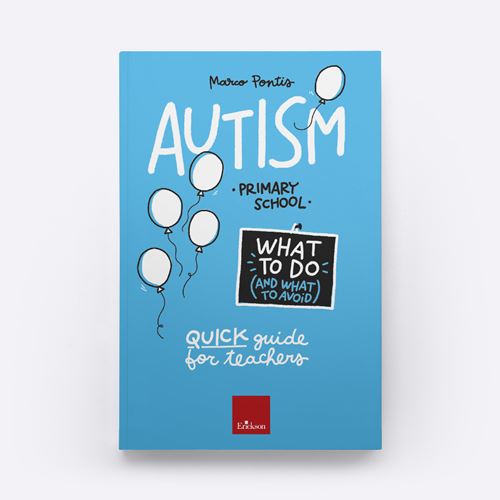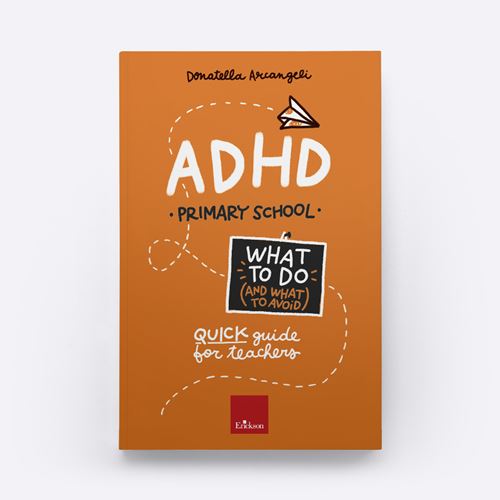 EN
EN
 PT
PT
Quick guide for teachers
Product: Book
Trim size in cm: 14x21cm
Pages: 152
ISBN: 9788859043928
Publication date: 01/10/2025
Suitable for: Primary 1st level (ages 6-7), Primary 2nd level (ages 8-10)
REQUEST A SAMPLE OR MORE INFORMATION
This book is the English version of the guide “Autism – What to do and what to avoid – Primary School”, translated directly by Edizioni Erickson.
In the style of a Teacher Training notebook, the guide presents targeted and ready-to-use instructions to successfully face 15 problematic situations and behaviours typical of autism spectrum disorder. The book is structured in 15 chapters divided into three macro-areas: social interaction, communication and behaviours, interests and activities – or the typical problem behaviours of children with autism spectrum disorder of school age between 6-11.
Presentation
Introduction
Social interaction
Ch 1 Avoids making eye-contact
Ch 2 Relates to others in a strange way
Ch 3 Doesn’t share activities and interests
Ch 4 Prefers to be alone
Ch 5 Has difficulty empathising with others
Communication
Ch 6 Has communication difficulties
Ch 7 Does not follow conversation norms
Ch 8 Does not understand humour or irony
Ch 9 Repeats words and phrases
Behaviour, interests, activities
Ch 10 Does not play pretend
Ch 11 Has particular, restricted or all-absorbing interests
Ch 12 Follows rigid and repetitive rituals
Ch 13 Has difficulty dealing with change
Ch 14 Carries out stereotypical movements
Ch 15 Had difficulty separating from some objects
Bibliography


THE GUIDES
Both volumes are designed for primary school and serve as a practical, immediately useful tool for teachers. With a clear, straightforward and highly accessible style, the guides address two key issues in school life: Autism and ADHD. The goal is to offer clear support, reducing uncertainty and providing effective, hands-on strategies.BOOK STRUCTURE
Each book opens with an introductory explanation of the main topic – to support teachers that may not know much about it. Then, the following chapters describe the most frequent situations occurring in the classroom and provide concrete suggestions on how to manage them. The reason for each behaviour is initially explained in a few brief sentences (Why does he/she do this?), followed by simple and clear indications for the teacher on the attitudes to be adopted and avoided (What to do, What to avoid). A discussion on the topic follows (What to keep in mind) and tools and strategies are provided in How to intervene regarding some crucial educational and didactic aspects. This is further explored in the paragraphs dedicated to Structuring and collaboration, guidelines are then drawn up with parents and other school workers (The educational pact). At the beginning of each chapter, a drawing introduces the analysed behaviour.
At the beginning of each chapter, a drawing introduces the analysed behaviour.
 • Explanations of the problem behaviour being considered: Why does he/she do this?
• Brief and simple indications that can be useful to the teacher as a reference point for quickly deciding What to do and reflect on What to avoid.
• Explanations of the problem behaviour being considered: Why does he/she do this?
• Brief and simple indications that can be useful to the teacher as a reference point for quickly deciding What to do and reflect on What to avoid.
 • A more in-depth description of the specific problem behaviour being worked on: Analysis of the problem behaviour.
• The tools and educational strategies to create the intervention: How to intervene.
• A more in-depth description of the specific problem behaviour being worked on: Analysis of the problem behaviour.
• The tools and educational strategies to create the intervention: How to intervene.
 Each chapter closes with The expert advice: reflections to further understand and enrich the teacher’s “briefcase of educational tools”.
Each chapter closes with The expert advice: reflections to further understand and enrich the teacher’s “briefcase of educational tools”.
ADVANTAGES OF THE BOOKS
To all countries where English is spoken as the first or the second main language, the books can stand as a benchmark for teachers and education professionals, coming with immediate advantages:
Autism - Primary school
Marco Pontis The book presents the most effective strategies for managing children with autism in the 6-11 year old age group, in primary school, offering clear, concise and concrete indications on what to do and what not to do in difficult classroom situations. Find out more!BOOK CONTENTS
The book is structured with 15 chapters, divided into 3 macro-areas:THE AUTHOR
Marco Pontis Teacher of Pedagogy and special didactics for intellectual disabilities and generalized developmental disorders as well as Pedagogy and special didactics for multi-professional collaboration at the University of Bolzano. For over fifteen year he has been working with and for people with autism spectrum disorders and other complex disabilities, constantly collaborating with family associations in the training of parents, school workers, socio-health care workers and supervising evidence-based educational interventions.
Adhd - Primary school
Donatella Arcangeli The volume supports primary school teachers who may not know much about ADHD or how to manage the most frequent situations occurring in the classroom with children aged 6 to 11. It draws a clear distinction between behaviours and attitudes to encourage, and those to avoid. Find out more!BOOK CONTENTS
The book is divided into 15 chapters, grouped into 3 macro-sections: Hyperactivity, Impulsivity, and Inattention:THE AUTHOR
Donatella Arcangeli is a doctor, and a child/adolescent neuropsychiatrist. In her clinic and training practice for health workers, social workers and teachers she dedicates herself to mental health in childhood, with particular attention to children with ADHD. For years she has been dealing with Teacher Training for school staff throughout the territory of the autonomous province of Bolzano, providing teachers with working tools for the management of students with special educational needs or disabilities.
Discover all the existing volumes of the What to do and what to avoid series available for translation. What to do and what to avoid